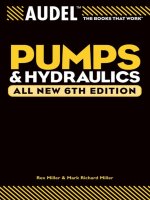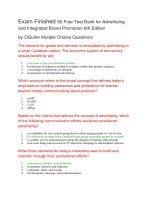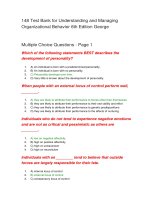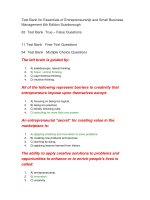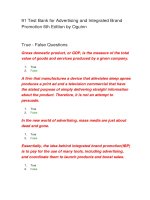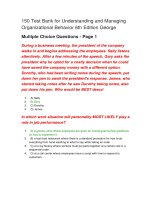audeltm pumps and hydraulics all new 6th edition
Bạn đang xem bản rút gọn của tài liệu. Xem và tải ngay bản đầy đủ của tài liệu tại đây (6.64 MB, 577 trang )
P1: FCH
GB098-FM GB098-Miller September 21, 2004 18:7 Char Count= 0
Audel
TM
Pumps and Hydraulics
All New 6th Edition
i
P1: FCH
GB098-FM GB098-Miller September 21, 2004 18:7 Char Count= 0
i
P1: FCH
GB098-FM GB098-Miller September 21, 2004 18:7 Char Count= 0
Audel
TM
Pumps and Hydraulics
All New 6th Edition
Rex Miller
Mark Richard Miller
Harry Stewart
i
P1: FCH
GB098-FM GB098-Miller September 21, 2004 18:7 Char Count= 0
Vice President and Executive Group Publisher: Richard Swadley
Vice President and Publisher: Joseph B. Wikert
Executive Editor: Carol A. Long
Editorial Manager: Kathryn A. Malm
Development Editor: Kevin Shafer
Production Editor: Vincent Kunkemueller
Text Design & Composition: TechBooks
Copyright
C
2004 by Wiley Publishing, Inc., Indianapolis, Indiana. All rights reserved.
Published simultaneously in Canada
No part of this publication may be reproduced, stored in a retrieval system or transmitted in any
form or by any means, electronic, mechanical, photocopying, recording, scanning or otherwise,
except as permitted under Sections 107 or 108 of the 1976 United States Copyright Act, without
either the prior written permission of the Publisher, or authorization through payment of the
appropriate per-copy fee to the Copyright Clearance Center, 222 Rosewood Drive, Danvers, MA
01923, (978) 750-8400, fax (978) 646-8600. Requests to the Publisher for permission should be
addressed to theLegal Department, Wiley Publishing, Inc., 10475 Crosspoint Blvd., Indianapolis,
IN 46256, (317) 572-3447, fax (317) 572-4355, e-mail:
Limit of Liability/Disclaimer of Warranty: The publisher and the author make no representa-
tions or warranties with respect to the accuracy or completeness of the contents of this work
and specifically disclaim all warranties, including without limitation warranties of fitness for a
particular purpose. No warranty may be created or extended by sales or promotional materials.
The advice and strategies contained herein may not be suitable for every situation. This work
is sold with the understanding that the publisher is not engaged in rendering legal, accounting,
or other professional services. If professional assistance is required, the services of a competent
professional person should be sought. Neither the publisher nor the author shall be liable for
damages arising herefrom. The fact that an organization or Website is referred to in this work
as a citation and/or a potential source of further information does not mean that the author or
the publisher endorses the information the organization or Website may provide or recommen-
dations it may make. Further, readers should be aware that Internet Websites listed in this work
may have changed or disappeared between when this work was written and when it is read.
For general information on our other products and services please contact our Customer Care
Department within the United States at (800) 762-2974, outside the United States at (317) 572-
3993 or fax (317) 572-4002.
Trademarks: Wiley, the Wiley Publishing logo, Audel, and The Books That Work are trademarks
or registered trademarks of John Wiley & Sons, Inc. and/or its affiliates. All other trademarks
are the property of their respective owners. Wiley Publishing, Inc., is not associated with any
product or vendor mentioned in this book.
Wiley also publishes its books in a variety of electronic formats. Some content that appears in
print may not be available in electronic books.
Library of Congress Control Number:
Printed in the United States of America
10987654321
ii
eISBN: 0-7645-7911-8
P1: FCH
GB098-FM GB098-Miller September 21, 2004 18:7 Char Count= 0
Contents
Acknowledgments xiii
About the Authors xv
Introduction xvii
PART I INTRODUCTION TO BASIC
PRINCIPLES OF PUMPS AND
HYDRAULICS
Chapter 1 Basic Fluid Principles 3
Physics 3
Matter 3
Body 4
Energy 5
Heat 7
Pressure 14
Barometer 21
Gravity 22
Force 26
Motion 28
Friction 34
Work and Power 36
Basic Machines 38
Lever 40
Wheel and Axle 41
Pulley 42
Inclined Plane 43
Screw 44
Wedge 45
Water 46
Properties of Water with Respect to
Pump Design 53
Pressure at Different Depths 54
Compressibility of Water 54
iii
P1: FCH
GB098-FM GB098-Miller September 21, 2004 18:7 Char Count= 0
iv Contents
Air 57
Humidity 57
Weight of Air 60
Summary 61
Review Questions 62
Chapter 2 Principles of Hydraulics 65
Basic Principles 65
Hydrostatics 69
Static Head 70
Static Lift 70
Displacement 72
Buoyancy 73
Hydrostatic Paradox 76
Hydrostatic Balance 76
Hydrodynamics 77
Dynamic Head 77
Dynamic Lift 78
Total Column 84
Friction of Water in Pipes 84
Flow of Water 89
Measurement of Water Flow 89
Siphon 96
Flow through Orifices 97
Specific Gravity 102
Summary 106
Review Questions 109
PART II PUMPS
Chapter 3 Centrifugal Pumps 113
Basic Principles 113
Pumps Having Straight Vanes 114
Pump Having Curved Vanes 114
The Volute 115
Curvature of the Impeller Vanes 117
Basic Classification 117
P1: FCH
GB098-FM GB098-Miller September 21, 2004 18:7 Char Count= 0
Contents v
Single-Stage Pump 118
Multistage Pump 119
Impellers 120
Balancing 123
Construction of Pumps 127
Casing or Housing 127
Impeller 127
Stuffing-Box Assembly 129
Bearings and Housings 129
Shaft Assembly 131
Drive 131
Installation 133
Location 133
Foundation 135
Leveling 135
Grouting 137
Inlet Piping 137
Discharge Piping 138
Pumps Handling High-Temperature
Liquids 138
Operation 139
Priming 140
Starting the Pump 143
Stopping the Pump 145
Abnormal Operating Conditions 146
Troubleshooting 146
Reduced Capacity or Pressure and
Failure to Deliver Water 147
Loses Water after Starting 147
Pump Overloads Driver 147
Pump Vibrates 148
Pointers on Pump Operation 148
Maintenance and Repair 149
Lateral End Clearances 149
Parts Renewals 149
Pointers on Assembly 150
P1: FCH
GB098-FM GB098-Miller September 21, 2004 18:7 Char Count= 0
vi Contents
Corrosion-Resisting Centrifugal Pumps 152
Typical Application — Plating 152
Corrosion-Resisting Pump Installation 155
Maintenance 157
Corrosion-Resisting Pump
Troubleshooting 158
Pump-End Assembly and Disassembly 158
Good Safety Practices 161
Impeller Design Considerations 162
Velocity of Impeller 163
Total Hydraulic Load or Lift 164
Velocity Head 164
Summary 173
Review Questions 174
Chapter 4 Rotary Pumps 177
Principles of Operation 177
Gear-Type Pumps 177
Vane-Type Pumps 180
Piston-Type Pumps 187
Construction 188
Gear-Type Pumps 190
Vane-Type Pumps 199
Piston-Type Pumps 200
Installation and Operation 204
Alignment 204
Drives for Rotary Gear Pumps 208
Power for Driving Pumps 208
Piping 209
Direction of Rotation 210
Starting and Operating the Pump 212
Practical Installation 212
Types of Gear Pumps 213
Pressure Relief Valve 215
Rotary Pump Troubleshooting 216
No Liquid Delivered 216
Insufficient Liquid Delivered 217
P1: FCH
GB098-FM GB098-Miller September 21, 2004 18:7 Char Count= 0
Contents vii
Pump Delivers for a Short Period, Then
Quits 217
Rapid Wear 217
Pump Requires Too Much Power 218
Noisy Operation 218
Calculations 218
Correct Size of Pump 219
Friction of Water in Pipes 219
Friction Loss in Rubber Hose 219
Dynamic Column or Total Load 221
Dynamic Lift 221
Dynamic Head 222
Horsepower Required 224
Summary 225
Review Questions 228
Chapter 5 Reciprocating Pumps 229
Principles of Operation 229
Lift Pumps 230
Force Pumps 231
Self-Priming or Siphon Pumps 239
Construction 240
Calculations 243
Lift 243
Size of Discharge Pipe 248
Head 248
Displacement 250
Piston Speed 251
Slip 252
Capacity 253
Efficiency 254
Summary 260
Review Questions 262
Chapter 6 Special-Service Pumps 265
Service Pumps 265
Chemical and Process Pumps 270
P1: FCH
GB098-FM GB098-Miller September 21, 2004 18:7 Char Count= 0
viii Contents
Pumps for Medical Use 273
Pumps for Handling of Sewage 274
Other Special-Service Pumps 275
Magma Pumps 276
Sump Pumps 276
Irrigation Pumps 281
Diaphragm-Type Pumps 282
Open-Diaphragm Pump 284
Advantages of Diaphragm Pumps 284
Shallow-Well and Deep-Well
Pumps 287
Rubber Impeller Pumps 296
Principles of Operation 297
Marine Applications 297
Tubing Pumps 298
Basic Principle of Operation 299
Lubricating the Tubing 301
Variable Speed 301
Types Available 301
Air Driven Pump 311
Multi-Tube Pumps 311
Chemical Pumping 312
Summary 312
Review Questions 313
PART III HYDRAULICS
Chapter 7 Hydraulic Accumulators 317
Basic Construction and Operation 317
Types of Accumulators 318
Weight-Loaded 319
Spring-Loaded Accumulators 324
Air- or Gas-Type Accumulators 324
Shock Absorbers or Alleviators 331
Air and Vacuum Chambers 334
Air Chambers 334
Vacuum Chambers 335
P1: FCH
GB098-FM GB098-Miller September 21, 2004 18:7 Char Count= 0
Contents ix
Accumulator Circuits 338
Summary 342
Review Questions 344
Chapter 8 Power Transmission 345
Hydraulic Drives 345
Basic Operating Principles 346
Tangential Acceleration 348
Tangential Deceleration 351
Types of Hydraulic Drives 352
Fluid Drive 352
Hydraulic Drive 356
Twin-Disk Hydraulic Drive 357
Hydraulic Torque Converter 358
Hydrostatic Transmission Systems 359
Hydraulic Adjustable-Speed Drive 367
Farm Tractor Applications 368
Pumps for Robots 371
CCS Systems 378
Summary 381
Review Questions 382
Chapter 9 Hydraulic Power Tools 383
Hydraulic Circuits 383
Hydraulic Motors 385
Types of Hydraulic Motors 389
Hydraulically Controlled Circuits 394
Combination Pump and Control Valve Unit 394
Remote Directional Control Valves 395
Operation of a Cylinder on a Machine Tool 398
Circuit Elements 398
Operation of the Hydraulic Circuit 402
Summary 403
Review Questions 403
Chapter 10 Hydraulic Cylinders 405
Nonrotating Cylinders 405
Names of Parts 407
P1: FCH
GB098-FM GB098-Miller September 21, 2004 18:7 Char Count= 0
x Contents
Force Developed in Nonrotating
Cylinders 415
Installation 418
Eccentric Loads 421
Causes of Failure 422
Repair and Maintenance 423
Rotating Cylinders 424
Names of Parts 424
Installation 428
Failure 430
Repair and Maintenance 430
Summary 432
Review Questions 432
Chapter 11 Control Valves 435
Pressure Controls 437
Pressure Relief 437
Sequence 438
Pressure Reducing 439
Counterbalance and Unloading 440
Operating Signals 441
Flow Controls 441
Needle 444
Noncompensating 444
Compensating 445
Directional Controls 447
Summary 450
Review Questions 451
Chapter 12 Hydraulic Control Valve Operators 453
Pressure-Control Valve Operators 453
Flow-Control Valve Operators 454
Directional Control Valve Operators 456
Manual Operators 456
Solenoid Operators 460
Mechanical Operators 463
Pilot Operators 465
P1: FCH
GB098-FM GB098-Miller September 21, 2004 18:7 Char Count= 0
Contents xi
Summary 468
Review Questions 469
PART IV FLUIDS, LINES, AND FITTINGS
Chapter 13 Hydraulic Fluids 473
Petroleum-Base Fluids 473
Synthetic-Base Fluids 473
Quality Requirements 474
Maintenance 475
Change of Fluids in a Hydraulic System 476
Selection of a Hydraulic Fluid 477
Specific Weight 477
Viscosity 478
Saybolt Universal Viscosimeter 478
Viscosity Problems 480
Viscosity Index 480
Lubricating Value 481
Pour Point 481
Oxidation and Contamination 481
Hydraulic Filters 482
Mobile-type Hydraulic Filter Units 485
Summary 488
Review Questions 488
Chapter 14 Fluid Lines and Fittings 491
Rigid Pipe 491
Semi-Rigid (Tubing) 492
Manufacturing Process 495
Other Types 497
Installation of Tubing 498
Flexible Piping (Hose) 499
Manifolds 505
Summary 507
Review Questions 507
Appendix A Pump Resources 509
P1: FCH
GB098-FM GB098-Miller September 21, 2004 18:7 Char Count= 0
xii Contents
Appendix B Oils and Fluids 511
Appendix C Latest Pumps Available 513
Index 531
P1: FCH
GB098-FM GB098-Miller September 21, 2004 18:7 Char Count= 0
Acknowledgments
No book can be written without the aid of many people. It takes a
great number of individuals to put together the information avail-
able about any particular technical field into a book. The field of
pumps and hydraulics is no exception. Many firms have contributed
information, illustrations, and analysis of the book.
The authors would like to thank every person involved for his
or her contributions. Following are some of the firms that supplied
technical information and illustrations.
Abex Corp., Denison Division
ABS
The Aldrich Pump Company, Standard Pump Div.
Becker Pumps
Brown and Sharpe Mfg. Co.
Buffalo Forge Company
Buffalo Pumps
Caterpillar Tractor Co.
Commercial Shearing Inc.
Continental Hydraulics
Deming Division, Crane Co.
Double A Products Co.
Gold Pumps
Gould Pumps
Hydreco, Div. of General Signal
Imperial-Eastern Corp.
Logansport Machine Co., Inc.
Lynair, Inc.
Marvel Engineering Co.
Mobile Aerial Towers, Inc.
Oilgear Company
Parker-Hannifin Corp.
Pathon Manufacturing Company, Div. of Parker-Hannifin Corp.
Pleuger Submersible Pumps, Inc.
Rexnard, Inc., Hydraulic Component Div.
Roper Pump Compan
Schrader Div., Scovil Mfg. Co.
Sherwood
xiii
P1: FCH
GB098-FM GB098-Miller September 21, 2004 18:7 Char Count= 0
xiv Acknowledgments
Snap-Tite, Inc.
Sperry Vickers, Division of Sperry Rand Corp.
Sunstrand Hydro-Transmission, Div. of Sundstrand Corp.
Superior Hydraulics, Div. of Superior Pipe Specialties
TAT Engineering
Viking Pump Division
The Weatherhead Co.
P1: FCH
GB098-FM GB098-Miller September 21, 2004 18:7 Char Count= 0
About the Authors
Rex Miller was a Professor of Industrial Technology at The State
University of New York, College at Buffalo for more than 35 years.
He has taught at the technical school, high school, and college level
for more than 40 years. He is the author or co-author of more than
100 textbooks ranging from electronics through carpentry and sheet
metal work. He has contributed more than 50 magazine articles over
the years to technical publications. He is also the author of seven
civil war regimental histories.
Mark Richard Miller finished his BS in New York and moved on
to Ball State University, where he earned a master’s degree, then
went to work in San Antonio. He taught high school and finished
his doctorate in College Station, Texas. He took a position at Texas
A&M University in Kingsville, Texas, where he now teaches in the
Industrial Technology Department as a Professor and Department
Chairman. He has co-authored 11 books and contributed many
articles to technical magazines. His hobbies include refinishing a
1970 Plymouth Super Bird and a 1971 Road-runner.
Harry L. Stewart was a professional engineer and is the author of
numerous books for the trades covering pumps, hydraulics, pneu-
matics, and fluid power.
xv
P1: FCH
GB098-FM GB098-Miller September 21, 2004 18:7 Char Count= 0
xvi
P1: FCH
GB098-FM GB098-Miller September 21, 2004 18:7 Char Count= 0
Introduction
The purpose of this book is to provide a better understanding of
the fundamentals and operating principles of pumps, pump con-
trols, and hydraulics. A thorough knowledge of pumps has become
more important, due to the large number of applications of pump
equipment in industry.
The applied principles and practical features of pumps and hy-
draulics are discussed in detail. Various installations, operations,
and maintenance procedures are also covered. The information con-
tained will be of help to engineering students, junior engineers and
designers, installation and maintenance technicians, shop mechan-
ics, and others who are interested in technical education and self-
advancement.
The correctservicing methods are of theutmost importance to the
service technician, since time and money can be lost when repeated
repairs are required. With the aid of this book, you should be able
to install and service pumps for nearly any application.
The authors would like to thank those manufacturers that pro-
vided illustrations, technicalinformation,and constructive criticism.
Special thanks to TAT Engineering and Sherwood Pumps.
xvii
P1: FCH
GB098-FM GB098-Miller September 21, 2004 18:7 Char Count= 0
xviii
P1: FCH
GB098-01 GB098-Miller September 13, 2004 17:28 Char Count= 0
Part I
Introduction to Basic
Principles of Pumps
and Hydraulics
1
P1: FCH
GB098-01 GB098-Miller September 13, 2004 17:28 Char Count= 0
2
P1: FCH
GB098-01 GB098-Miller September 13, 2004 17:28 Char Count= 0
Chapter 1
Basic Fluid Principles
Pumps are devices that expend energy to raise, transport, or com-
press fluids. The earliest pumps were made for raising water. These
are known today as Persian and Roman waterwheels and the more
sophisticated Archimedes screw.
Mining operations of the Middle Ages led to development of the
suction or piston pump. There are many types of suction pumps.
They were described by Georgius Agricola in his De re Metallica
written in 1556 a.d.A suction pump works byatmosphericpressure.
That means when the piston is raised, it creates a partial vacuum.
The outside atmospheric pressure thenforces water into the cylinder.
From there, it is permitted to escape by way of an outlet valve.
Atmospheric pressure alone can force water to a maximum height
of about 34 feet (10 meters). So, the force pump was developed to
drain deeper mines. The downward stroke of the force pump forces
water out through a side valve. The height raised depends on the
force applied to the piston.
Fluid is employed in aclosed system asa medium to cause motion,
either linear or rotary. Because of improvements in seals, materials,
and machining techniques, the use of fluids to control motions has
greatly increased in the recent past.
Fluid can be either in a liquid or gaseous state. Air, oil, water,
oxygen, and nitrogen are examples of fluids. They can all be pumped
by today’s highly improved devices.
Physics
A branch of science that deals with matter and energy and their
interactions in the fieldofmechanics, electricity, nuclear phenomena,
and others is called physics. Some of the basic principles of fluids
must be studied before subsequent chapters in this book can be
understood properly.
Matter
Matter canbe defined as anything that occupies space, and all matter
has inertia. Inertia is that property of matter by which it will remain
at rest or in uniform motion in the same straight line or direction un-
less acted upon by some external force. Matter is any substance that
can be weighed or measured. Matter may exist in one of three states:
r
Solid (coal, iron, ice)
r
Liquid (oil, alcohol, water)
r
Gas (air, hydrogen, helium)
3
P1: FCH
GB098-01 GB098-Miller September 13, 2004 17:28 Char Count= 0
4 Chapter 1
Water is the familiar example of a substance that exists in each of the
three states of matter (see Figure 1-1) as ice (solid), water (liquid),
and steam (gas).
SOLID (FIRST STATE)
AIR ABOVE 32°
ICE 32°
FUSION (CHANGE FROM
SOLID TO LIQUID)
VAPORIZATION
(CHANGE FROM
LIQUID TO GAS)
WATER
LIQUID (SECOND STATE)
212° WATER
STEAM BUBBLES
STEAM
GAS (THIRD STATE)
Figure 1-1 The three states of matter: solid, liquid, and gas. Note that
the change of state from a solid to a liquid is called fusion, and the change
of state from liquid to a gas is called vaporization.
Body
A body is a mass of matter that has a definite quantity. For example,
a mass of iron 3 inches × 3 inches × 3 inches has a definite quantity
of 27 cubic inches. It also has a definite weight. This weight can be
determined by placing the body on a scale (either a lever or platform
scale or a spring scale). If an accurate weight is required, a lever or
platform scale should be employed. Since weight depends on gravity,
and since gravity decreases with elevation, the reading on a spring
scale varies, as shown in Figure 1-2.



